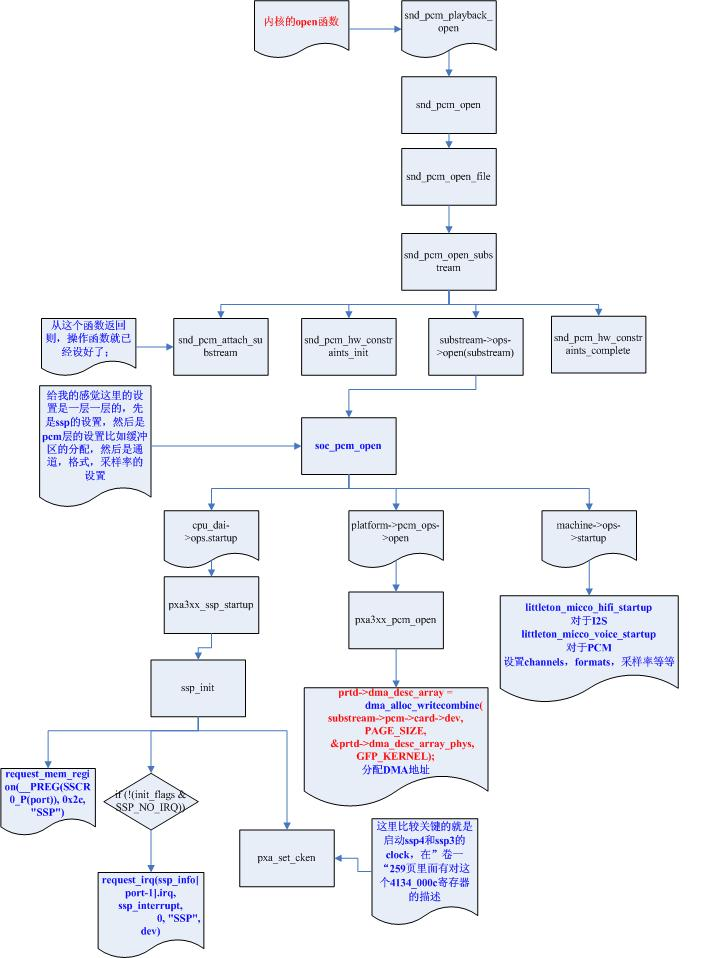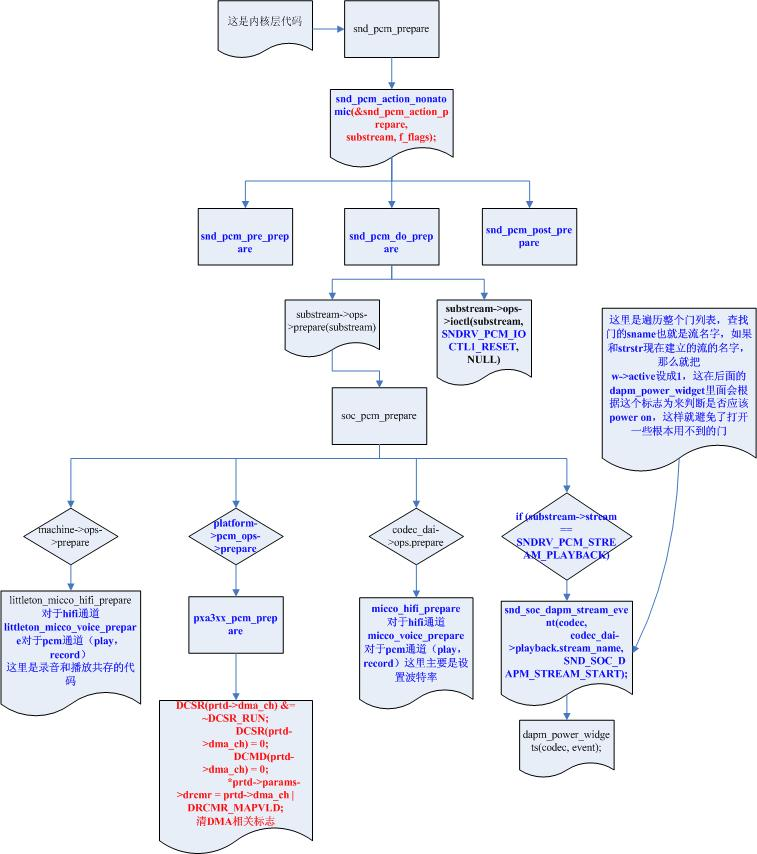alsa声卡分析alsa-utils调用过程
如何分析tinyplay 播放音频和tinymix的过程?需要相应的工具来支持追查;
一、分析tinyplay和tinymix:
1.1 利用strace工具:
strace -o tinyplay.log tinyplay 1.wav
strace -o tinymixer.log tinymixer "SEC_MI2S_RX Audio Mixer MultiMedia1" 1
利用strace工具获取APP的log,从应用层往下看;
1.2 分析alsa-utils源码:
tiny工具源码在android/external/tinyalsa目录下;
二、tinyplay调用分析(tinyplay.log搜索设备节点“/dev/snd/pcmC0D0p”)
2.1 tinyplay的open过程:
snd_pcm_f_ops[0]是播放音频的file_operations,snd_pcm_f_ops[1]则是录音的file_operations:
- const struct file_operations snd_pcm_f_ops[] = {
- {
- .owner = THIS_MODULE,
- .write = snd_pcm_write,
- .aio_write = snd_pcm_aio_write,
- .open = snd_pcm_playback_open,
- .release = snd_pcm_release,
- .llseek = no_llseek,
- .poll = snd_pcm_playback_poll,
- .unlocked_ioctl = snd_pcm_playback_ioctl,
- .compat_ioctl = snd_pcm_ioctl_compat,
- .mmap = snd_pcm_mmap,
- .fasync = snd_pcm_fasync,
- .get_unmapped_area = snd_pcm_get_unmapped_area,
- },
- {
- .owner = THIS_MODULE,
- .read = snd_pcm_read,
- .aio_read = snd_pcm_aio_read,
- .open = snd_pcm_capture_open,
- .release = snd_pcm_release,
- .llseek = no_llseek,
- .poll = snd_pcm_capture_poll,
- .unlocked_ioctl = snd_pcm_capture_ioctl,
- .compat_ioctl = snd_pcm_ioctl_compat,
- .mmap = snd_pcm_mmap,
- .fasync = snd_pcm_fasync,
- .get_unmapped_area = snd_pcm_get_unmapped_area,
- }
- };
我们从snd_pcm_playback_open函数开始向下分析:
- static int snd_pcm_playback_open(struct inode *inode, struct file *file)
- {
- struct snd_pcm *pcm;
- int err = nonseekable_open(inode, file);
- if (err < )
- return err;
- pcm = snd_lookup_minor_data(iminor(inode),
- SNDRV_DEVICE_TYPE_PCM_PLAYBACK); //取得其私有数据并返回的
- err = snd_pcm_open(file, pcm, SNDRV_PCM_STREAM_PLAYBACK);
- if (pcm)
- snd_card_unref(pcm->card); //减少设备对象的引用计数 snd_card_unref(card);
- return err;
- }
在下面调用了snd_pcm_open函数:
- static int snd_pcm_open(struct file *file, struct snd_pcm *pcm, int stream)
- {
- int err;
- wait_queue_t wait;
- if (pcm == NULL) {
- err = -ENODEV;
- goto __error1;
- }
- err = snd_card_file_add(pcm->card, file);
- if (err < )
- goto __error1;
- if (!try_module_get(pcm->card->module)) {
- err = -EFAULT;
- goto __error2;
- }
- init_waitqueue_entry(&wait, current);
- add_wait_queue(&pcm->open_wait, &wait);
- mutex_lock(&pcm->open_mutex);
- while () {
- err = snd_pcm_open_file(file, pcm, stream); // 将操作该声卡card的应用程序添加到card->files_list
- if (err >= )
- break;
- if (err == -EAGAIN) {
- if (file->f_flags & O_NONBLOCK) {
- err = -EBUSY;
- break;
- }
- } else
- break;
- set_current_state(TASK_INTERRUPTIBLE);
- mutex_unlock(&pcm->open_mutex);
- schedule();
- mutex_lock(&pcm->open_mutex);
- if (pcm->card->shutdown) {
- err = -ENODEV;
- break;
- }
- if (signal_pending(current)) {
- err = -ERESTARTSYS;
- break;
- }
- }
- remove_wait_queue(&pcm->open_wait, &wait);
- mutex_unlock(&pcm->open_mutex);
- if (err < )
- goto __error;
- return err;
- __error:
- module_put(pcm->card->module);
- __error2:
- snd_card_file_remove(pcm->card, file);
- __error1:
- return err;
- }
再从snd_pcm_open_file继续向下看:
- static int snd_pcm_open_file(struct file *file,
- struct snd_pcm *pcm,
- int stream)
- {
- struct snd_pcm_file *pcm_file;
- struct snd_pcm_substream *substream;
- int err;
- err = snd_pcm_open_substream(pcm, stream, file, &substream); //打开substream结构体
- if (err < )
- return err;
- pcm_file = kzalloc(sizeof(*pcm_file), GFP_KERNEL);
- if (pcm_file == NULL) {
- snd_pcm_release_substream(substream);
- return -ENOMEM;
- }
- pcm_file->substream = substream;
- if (substream->ref_count == ) {
- substream->file = pcm_file;
- substream->pcm_release = pcm_release_private;
- }
- file->private_data = pcm_file;
- return ;
- }
- int snd_pcm_open_substream(struct snd_pcm *pcm, int stream,
- struct file *file,
- struct snd_pcm_substream **rsubstream)
- {
- struct snd_pcm_substream *substream;
- int err;
- err = snd_pcm_attach_substream(pcm, stream, file, &substream);
- if (err < )
- return err;
- if (substream->ref_count > ) {
- *rsubstream = substream;
- return ;
- }
- err = snd_pcm_hw_constraints_init(substream); //初始化substream结构体
- if (err < ) {
- snd_printd("snd_pcm_hw_constraints_init failed\n");
- goto error;
- }
- if ((err = substream->ops->open(substream)) < )
- goto error;
- substream->hw_opened = ;
- err = snd_pcm_hw_constraints_complete(substream);
- if (err < ) {
- snd_printd("snd_pcm_hw_constraints_complete failed\n");
- goto error;
- }
- *rsubstream = substream;
- return ;
- error:
- snd_pcm_release_substream(substream);
- return err;
- }
snd_pcm_open_substream
在snd_pcm_open_substream函数中:
- if ((err = substream->ops->open(substream)) < ) // substream->ops : snd_pcm_ops结构体
- goto error;
依次调用cpu_dai, dma, codec_dai, machine(三大模块)的open或startup函数;
msm_mi2s_snd_startup函数:
- struct snd_soc_pcm_runtime *rtd = substream->private_data;
- struct snd_soc_card *card = rtd->card;
- struct snd_soc_dai *cpu_dai = rtd->cpu_dai;
- struct snd_soc_codec *codec = rtd->codec;
设置snd_soc_pcm_runtime的cpu、codec等模块;然后在snd_soc_pcm_runtime函数中对codec函数进行相应的设置,之后通过音频数据流通道播放出声音;
调用过程如下图:

2.2 tinyplay的ioctl过程:
同样也是snd_pcm_f_ops[0]结构体的file_operations:
- {
- .owner = THIS_MODULE,
- .write = snd_pcm_write,
- .aio_write = snd_pcm_aio_write,
- .open = snd_pcm_playback_open,
- .release = snd_pcm_release,
- .llseek = no_llseek,
- .poll = snd_pcm_playback_poll,
- .unlocked_ioctl = snd_pcm_playback_ioctl,
- .compat_ioctl = snd_pcm_ioctl_compat,
- .mmap = snd_pcm_mmap,
- .fasync = snd_pcm_fasync,
- .get_unmapped_area = snd_pcm_get_unmapped_area,
- },
从snd_pcm_playback_ioctl函数向下看:
- static long snd_pcm_playback_ioctl(struct file *file, unsigned int cmd,
- unsigned long arg)
- {
- struct snd_pcm_file *pcm_file;
- pcm_file = file->private_data; //获取相应的私有数据
- if ((((cmd >> ) & 0xff) != 'A') && (((cmd >> ) & 0xff) != 'C'))
- return -ENOTTY;
- return snd_pcm_playback_ioctl1(file, pcm_file->substream, cmd,
- (void __user *)arg);
- }
snd_pcm_playback_ioctl1:
- static int snd_pcm_playback_ioctl1(struct file *file,
- struct snd_pcm_substream *substream,
- unsigned int cmd, void __user *arg)
- {
- if (snd_BUG_ON(!substream))
- return -ENXIO;
- if (snd_BUG_ON(substream->stream != SNDRV_PCM_STREAM_PLAYBACK))
- return -EINVAL;
- //根据case不同,对播放进行相应的不同操作
- switch (cmd) {
- case SNDRV_PCM_IOCTL_WRITEI_FRAMES:
- {
- struct snd_xferi xferi;
- struct snd_xferi __user *_xferi = arg;
- struct snd_pcm_runtime *runtime = substream->runtime;
- snd_pcm_sframes_t result;
- if (runtime->status->state == SNDRV_PCM_STATE_OPEN)
- return -EBADFD;
- if (put_user(, &_xferi->result))
- return -EFAULT;
- if (copy_from_user(&xferi, _xferi, sizeof(xferi)))
- return -EFAULT;
- result = snd_pcm_lib_write(substream, xferi.buf, xferi.frames);
- __put_user(result, &_xferi->result);
- return result < ? result : ;
- }
- case SNDRV_PCM_IOCTL_WRITEN_FRAMES:
- {
- struct snd_xfern xfern;
- struct snd_xfern __user *_xfern = arg;
- struct snd_pcm_runtime *runtime = substream->runtime;
- void __user **bufs;
- snd_pcm_sframes_t result;
- if (runtime->status->state == SNDRV_PCM_STATE_OPEN)
- return -EBADFD;
- if (runtime->channels > )
- return -EINVAL;
- if (put_user(, &_xfern->result))
- return -EFAULT;
- if (copy_from_user(&xfern, _xfern, sizeof(xfern)))
- return -EFAULT;
- bufs = memdup_user(xfern.bufs,
- sizeof(void *) * runtime->channels);
- if (IS_ERR(bufs))
- return PTR_ERR(bufs);
- result = snd_pcm_lib_writev(substream, bufs, xfern.frames);
- kfree(bufs);
- __put_user(result, &_xfern->result);
- return result < ? result : ;
- }
- case SNDRV_PCM_IOCTL_REWIND:
- {
- snd_pcm_uframes_t frames;
- snd_pcm_uframes_t __user *_frames = arg;
- snd_pcm_sframes_t result;
- if (get_user(frames, _frames))
- return -EFAULT;
- if (put_user(, _frames))
- return -EFAULT;
- result = snd_pcm_playback_rewind(substream, frames);
- __put_user(result, _frames);
- return result < ? result : ;
- }
- case SNDRV_PCM_IOCTL_FORWARD:
- {
- snd_pcm_uframes_t frames;
- snd_pcm_uframes_t __user *_frames = arg;
- snd_pcm_sframes_t result;
- if (get_user(frames, _frames))
- return -EFAULT;
- if (put_user(, _frames))
- return -EFAULT;
- result = snd_pcm_playback_forward(substream, frames);
- __put_user(result, _frames);
- return result < ? result : ;
- }
- }
- return snd_pcm_common_ioctl1(file, substream, cmd, arg);
- }
从snd_pcm_common_ioctl1继续分析,进入函数的prepare中:
当函数prepare完毕后,就一切准备就绪了,只等一个trigger;而trigger的执行会在上层的alsalib调用write的函数触发;prepare过程可以看下图,具体就不继续分析了:

下一节我们将来分析tinymixer的调用过程;
alsa声卡分析alsa-utils调用过程(二)-tinymixer
alsa声卡分析alsa-utils调用过程的更多相关文章
- alsa声卡分析alsa-utils调用过程(一)-tinyplay
如何分析tinyplay 播放音频和tinymix的过程?需要相应的工具来支持追查: 一.分析tinyplay和tinymix: 1.1 利用strace工具: strace -o tinyplay. ...
- Spring源码分析之`BeanFactoryPostProcessor`调用过程
前文传送门: Spring源码分析之预启动流程 Spring源码分析之BeanFactory体系结构 本文内容: AbstractApplicationContext#refresh前部分的一点小内容 ...
- alsa声卡分析alsa-utils调用过程(二)-tinymixer
继上一篇文章:http://www.cnblogs.com/linhaostudy/p/8515277.html 三.tinymixer调用分析:(tinymixer.log搜索节点:/dev/snd ...
- mybatis源码分析(方法调用过程)
十一月月底,宿舍楼失火啦,搞得20多天没有网,目测直到放假也不会来了... 正题 嗯~,其实阅读源码不是为了应付面试,更重要的让你知道,大师是怎样去写代码的,同样是用Java,为啥Clinton Be ...
- Openstack Nova 源码分析 — RPC 远程调用过程
目录 目录 Nova Project Services Project 的程序入口 setuppy Nova中RPC远程过程调用 nova-compute RPC API的实现 novacompute ...
- ALSA声卡07_分析调用过程_学习笔记
1.编译新的strace工具分析aplay和amixer应用程序对声卡的调用过程 (1)因为旧的strace工具不能识别不能识别alsa声卡驱动程序里面的ioctrl. (2)编译过程参考http:/ ...
- ALSA声卡笔记1---ALSA驱动框架
1.声卡驱动程序sound.c (1)入口函数里通过register_chrdev()函数注册file_operations 结构体 (2)file_operations 结构体,里面只有open函数 ...
- ALSA声卡驱动中的DAPM详解之七:dapm事件机制(dapm event)
前面的六篇文章,我们已经讨论了dapm关于动态电源管理的有关知识,包括widget的创建和初始化,widget之间的连接以及widget的上下电顺序等等.本章我们准备讨论dapm框架中的另一个机制:事 ...
- ALSA声卡驱动中的DAPM详解之五:建立widget之间的连接关系
前面我们主要着重于codec.platform.machine驱动程序中如何使用和建立dapm所需要的widget,route,这些是音频驱动开发人员必须要了解的内容,经过前几章的介绍,我们应该知道如 ...
随机推荐
- 【php】phpExcel使用教程,如何导出excel表格
[1]下载phpExcel类文件 可在官方去下载 我们只需要classes中的文件,把Classes文件复制到项目中 只需要2个文件就可以了 一个就是phpExcel(刚才我们复制过来的文件 Cla ...
- linux配置上网
重装系统之后,配置虚拟机的网络问题花了我三个小时,忘记了网关是vmnet8的IP还是DNS了,搞了很久,后来碰运气碰对了. 寄宿机共享的网络是vmnet8,设置IP,DNS,是vmnet8 的IPv4 ...
- docker命令行学习
docker命令行学习 docker run docker run --help:老实说这条最管用了 docker run -it:交互模式,允许控制台输出 docker run -d:detach, ...
- BZOJ 3729: Gty的游戏 [伪ETT 博弈论]【学习笔记】
题意: 给定一棵有根树,每个节点有一些石子,每次可以将不多于k的石子移动到父节点 修改一个点的石子数,插入一个点,询问某棵子树是否先手必胜 显然是一个阶梯Nim 每次最多取k个,找规律或者观察式子易发 ...
- BZOJ 1856: [Scoi2010]字符串 [Catalan数]
1856: [Scoi2010]字符串 Time Limit: 5 Sec Memory Limit: 64 MBSubmit: 1418 Solved: 790[Submit][Status][ ...
- BZOJ 2111: [ZJOI2010]Perm 排列计数 [Lucas定理]
2111: [ZJOI2010]Perm 排列计数 Time Limit: 10 Sec Memory Limit: 259 MBSubmit: 1936 Solved: 477[Submit][ ...
- HDU1013,1163 ,2035九余数定理 快速幂取模
1.HDU1013求一个positive integer的digital root,即不停的求数位和,直到数位和为一位数即为数根. 一开始,以为integer嘛,指整型就行吧= =(too young ...
- 记一次酷狗音乐API的获取,感兴趣的可以自己封装开发自己的音乐播放器
1.本教程仅供个人学习用,禁止用于任何的商业和非法用途,如涉及版权问题请联系笔者删除. 2.随笔系作者原创文档,转载请注明文档来源:http://www.cnblogs.com/apresunday/ ...
- Selenium_WebDriver_控制浏览器
版权声明:本文为博主原创文章,转载请注明出处. 浏览器环境: ①GoogleChrome:60 ②chromedriver:2.30: 访问 操作 方法 示例 访问页面 void get(java. ...
- [Python Study Notes] Python的安装
Windows: 1.下载安装包: 转到Python官网https://www.python.org/downloads/ ,下载最新版本的Python. 2.安装 安装到自定义的安装路径下. 3. ...
